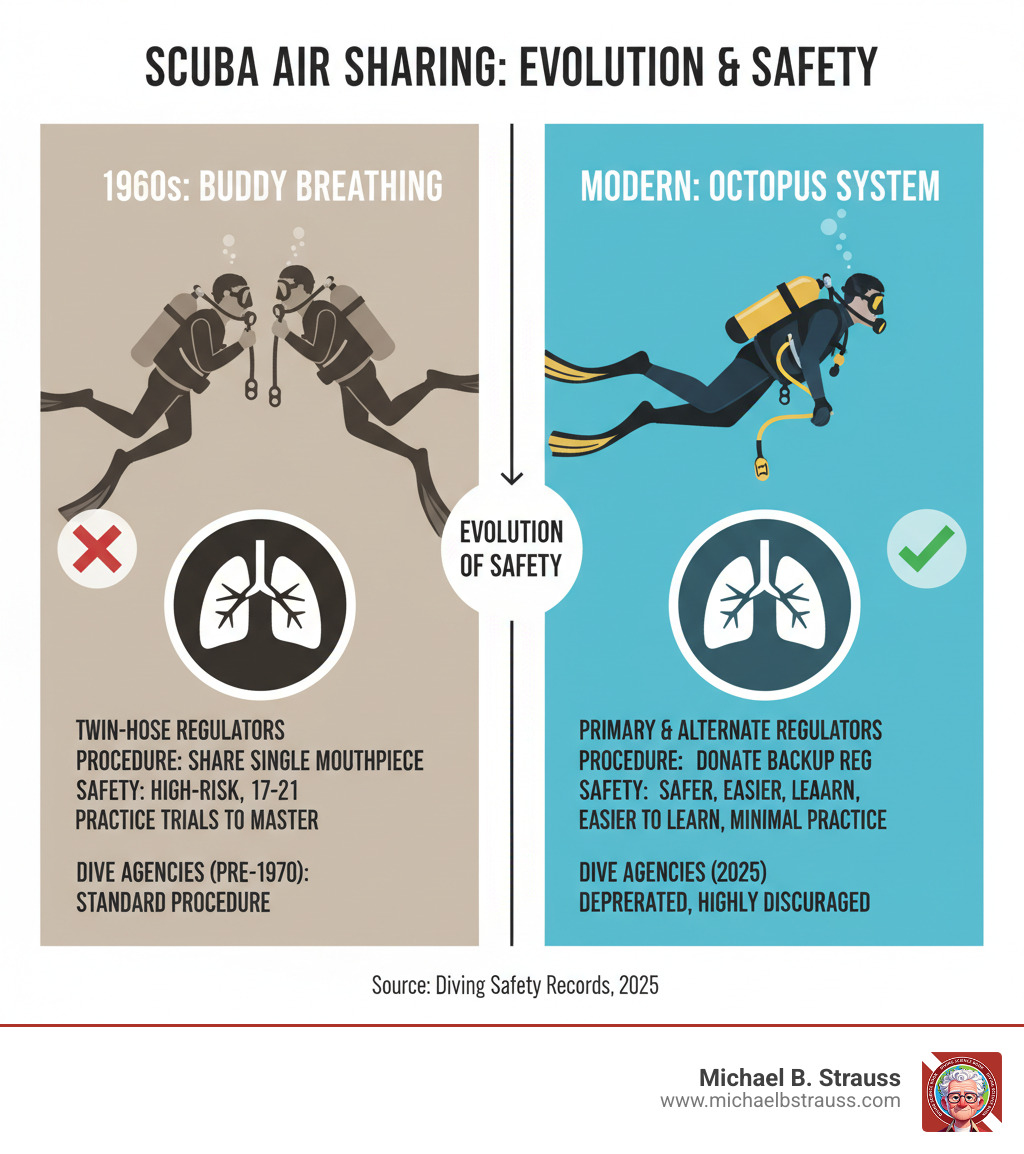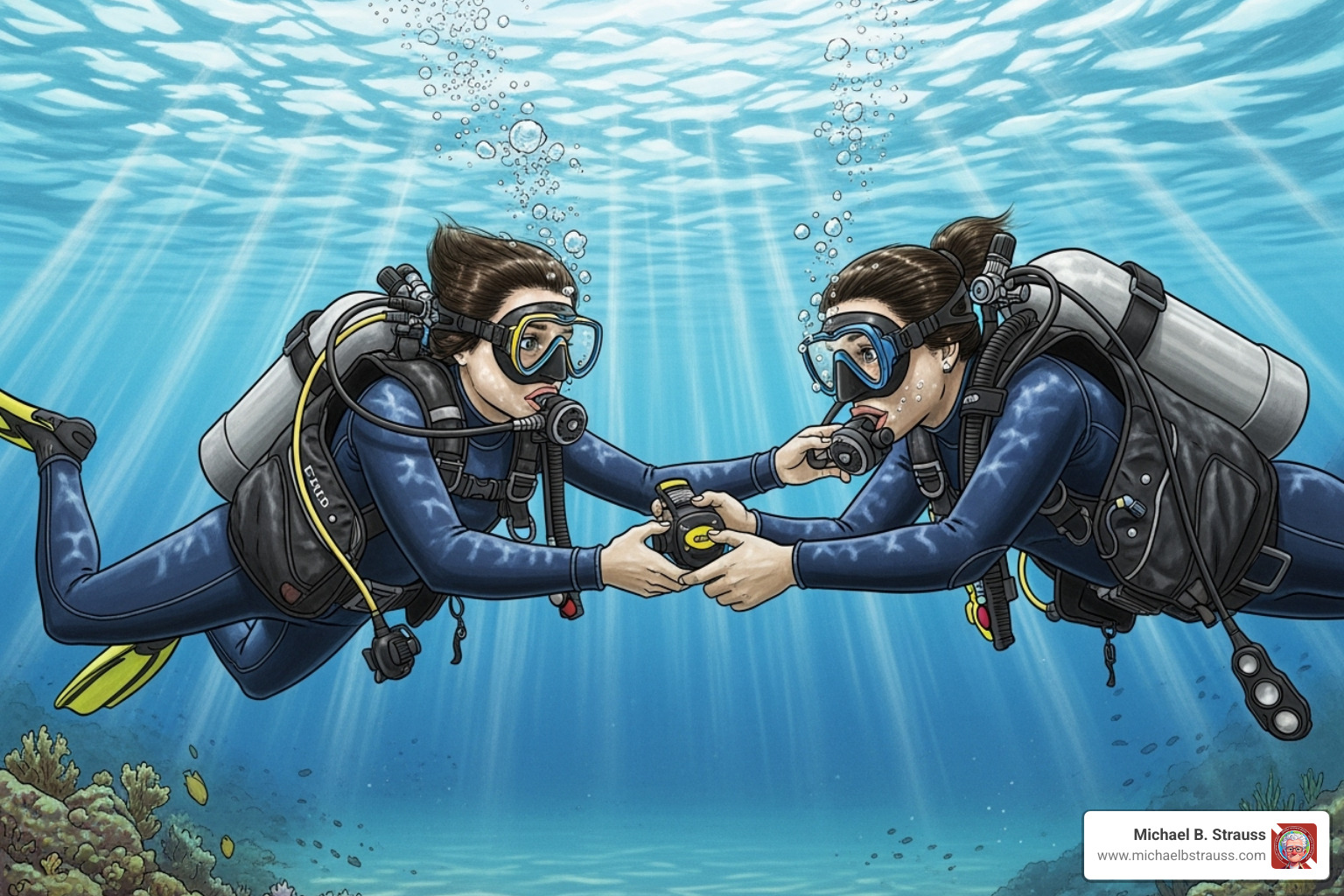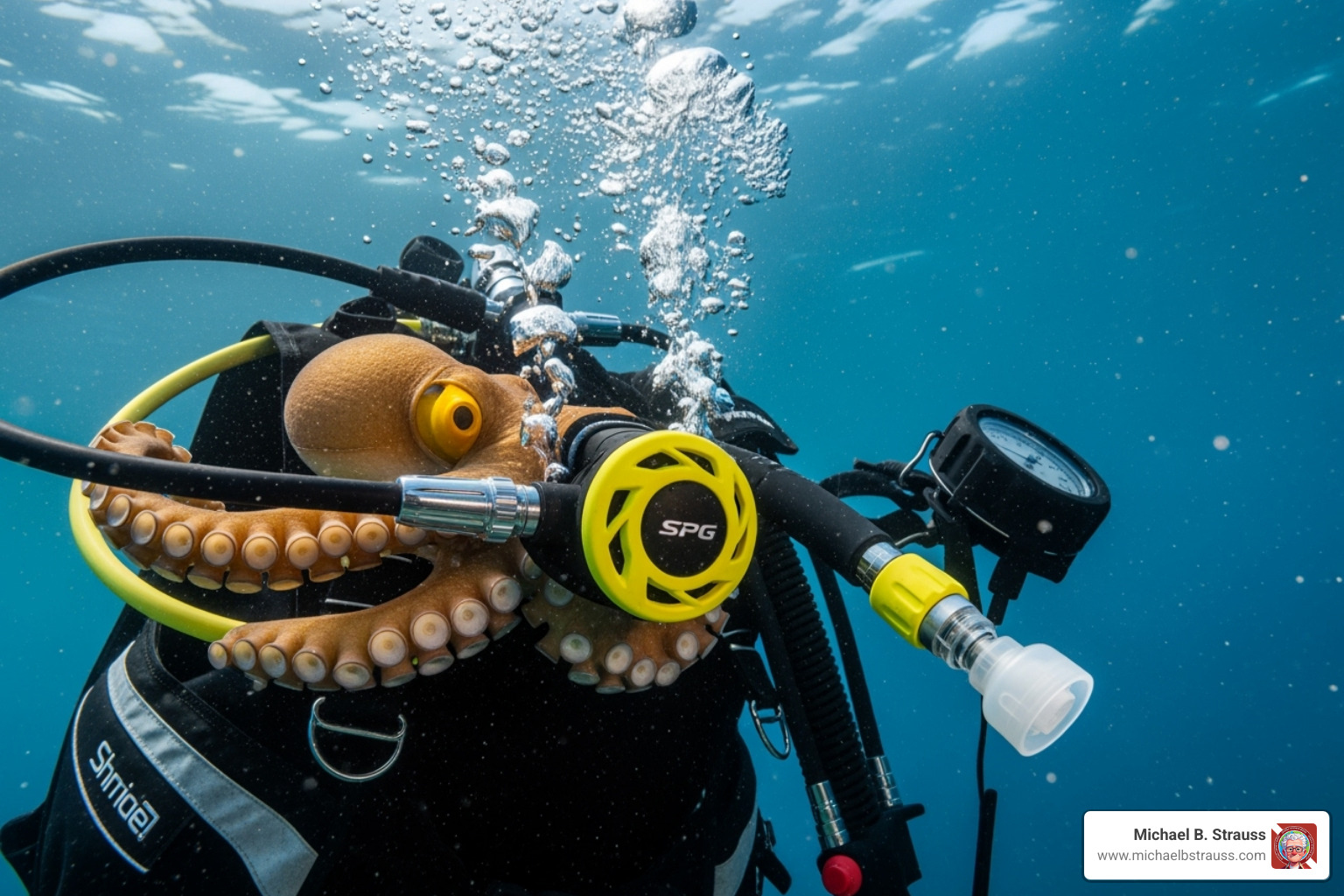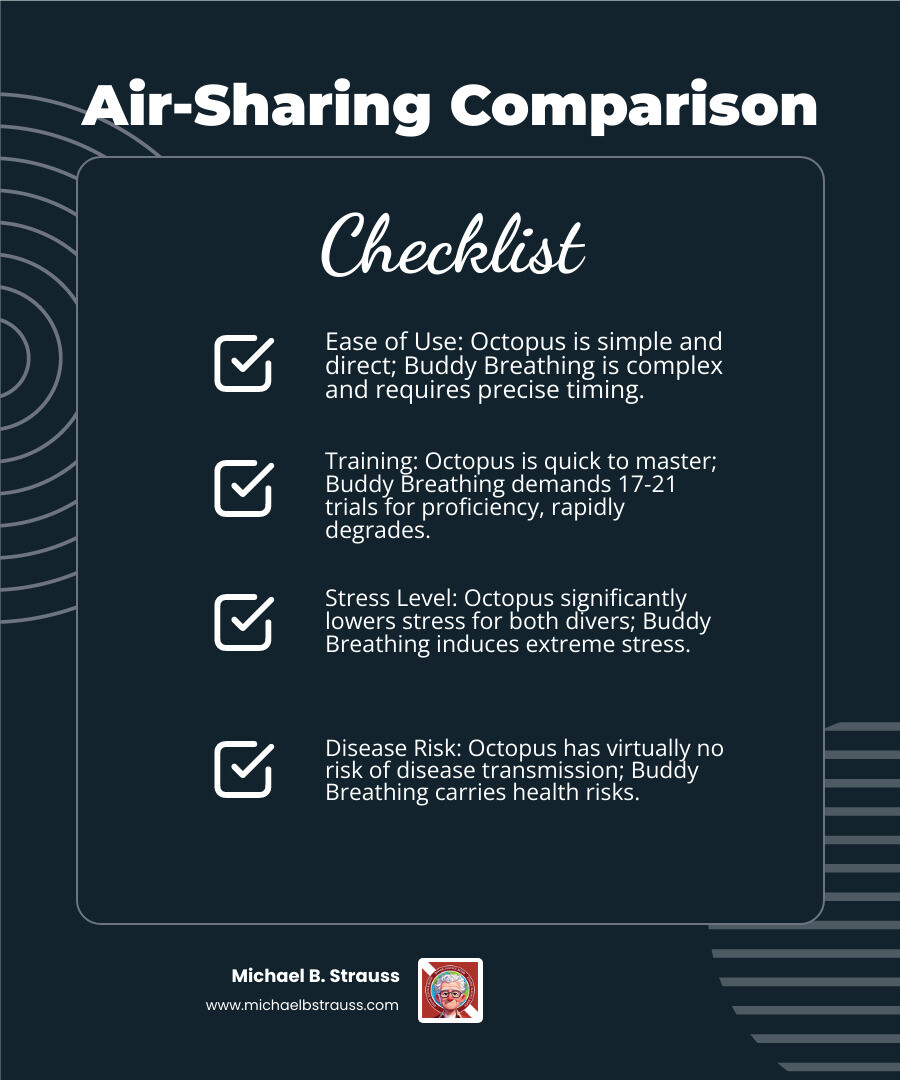Why Understanding the Buddy Breathing Technique Matters for Diving Safety
The buddy breathing technique is a controversial emergency procedure where two scuba divers share a single regulator, alternating breaths during an out-of-air emergency. While largely replaced by modern alternatives, understanding this technique remains important for diving safety education.
Quick Answer - Buddy Breathing Technique Steps:
- Signal - Out-of-air diver signals emergency to buddy
- Position - Divers face each other, maintain physical contact
- Share - Donor passes regulator after taking a breath
- Breathe - Each diver takes two breaths before passing back
- Ascend - Begin slow, controlled ascent to surface
- Control - Donor maintains grip on regulator hose throughout
Buddy breathing emerged from military diving in the 1960s when divers lacked pressure gauges and backup regulators. Back then, running out of air was common, and sharing a single mouthpiece was often the only option for survival.
Today, the technique tells a different story. Most major diving agencies have deprecated buddy breathing due to its high risk profile. Research shows it requires 17 to 21 practice trials to master, and most divers lose proficiency within 90 days without regular practice.
The procedure creates what diving safety experts call "double jeopardy" - where one diver's panic or incompetence can kill both participants. Poor buddy breathing performance has resulted in the death of both divers on multiple documented occasions.
Modern diving relies on alternate air sources (octopus regulators) and bailout cylinders instead. These alternatives are safer, easier to learn, and don't require the extensive ongoing practice that buddy breathing demands.

The Buddy Breathing Technique: History, Procedure, and Risks
In the early days of scuba, an out-of-air emergency 60 feet underwater had one solution: the buddy breathing technique. This procedure involved two divers sharing a single regulator, taking turns breathing during a controlled ascent. While modern diving has largely moved on, understanding this technique offers valuable insight into diving safety evolution.
A Step-by-Step Guide to the Classic Buddy Breathing Technique
The buddy breathing technique required flawless coordination and composure under extreme stress. It was a complex dance of survival between partners.

- Emergency Signal: The process starts with the universal out-of-air signal (a hand-across-the-throat gesture). Clear communication is critical.
- Positioning: The donor establishes physical contact, gripping the buddy's arms or shoulders for stability. Face-to-face positioning is ideal for the regulator exchange.
- Donor's Role: The donor takes a breath, then passes their regulator while maintaining a firm grip on the hose. This control prevents a panicked recipient from keeping the regulator too long.
- Recipient's Role: The recipient purges the regulator of water and takes exactly two controlled breaths before returning it. This two-breath rhythm is crucial to ensure both divers get enough air.
- Controlled Ascent: While sharing air, the divers begin a slow, steady ascent, managing their rate to avoid decompression sickness.
- Buoyancy Control: The donor typically manages buoyancy for both divers, a difficult task while coordinating breathing and ascent under duress.
Executing these steps simultaneously while fighting panic responses made buddy breathing an incredibly challenging skill.
The Evolution and Decline of a Diving Staple
Buddy breathing originated in military diving in the 1950s out of necessity. Early divers used twin-hose regulators but lacked submersible pressure gauges (SPGs), making out-of-air emergencies common. With no backup systems, buddy breathing was the only option.
The introduction of single-hose regulators in the mid-1960s made air sharing more awkward. The arrival of SPGs was a game-changer, allowing divers to monitor their air supply and making surprise emergencies far less frequent.
Later, Buoyancy Compensators (BCs) added another layer of complexity, as divers now had to manage BC inflation during an already difficult emergency ascent. As safer alternatives emerged, training agencies began phasing out buddy breathing as a primary skill throughout the 1990s, turning this once-essential technique into a historical footnote.
This evolution reflects our growing understanding of diving safety. For more details about this fascinating history, you can read more on the history of buddy breathing.
Why the Buddy Breathing Technique is a High-Risk Skill
Despite its historical importance, the buddy breathing technique carries serious risks that make it unsuitable for modern recreational diving.
- High Task Loading: The technique requires divers to juggle breathing, regulator exchange, ascent, and buoyancy control simultaneously. This mental overload often leads to dangerous, uncontrolled ascents.
- Panic and Double Jeopardy: An out-of-air diver's panic can override training. A panicked recipient might refuse to return the regulator, creating a "double jeopardy" scenario where one person's actions can lead to the death of both. Double fatalities from failed buddy breathing attempts are well-documented.
- Disease Transmission: Sharing a mouthpiece carries a risk of transmitting diseases like Hepatitis B and Herpes.
- Extensive Practice and Skill Fade: Research shows mastering the technique requires 17-21 practice sessions, and proficiency is lost within 90 days without regular practice. This means most divers are unlikely to perform it effectively in a real emergency.
The combination of these factors explains why the diving community has acceptd safer alternatives. For more information about diving-related medical concerns, you can explore more info on diving medical problems.
The Modern Approach to Air-Sharing Emergencies
Modern diving safety philosophy prioritizes simplicity and reliability in emergencies, a stark contrast to the complexity of the buddy breathing technique. Today's methods are easier to execute and more effective when seconds count.
Safer Skies Below: The Alternate Air Source (Octopus)
The widespread adoption of the alternate air source, or "octopus regulator," has revolutionized air-sharing emergencies. This is a second regulator connected to the primary first stage, ready for immediate use.

Instead of the complex exchange of buddy breathing, a diver simply hands their buddy the octopus. Both divers can then breathe continuously, allowing them to focus on a safe ascent. Most octopus regulators are bright yellow for high visibility in an emergency.
Common configurations include:
- Standard Setup: The octopus has a longer hose (around 100cm) and is clipped to the chest for easy access.
- Hogarthian Configuration: Popular with technical divers, this setup uses a long hose (200cm) on the primary regulator, which is donated in an emergency. The donor then switches to a backup regulator on a shorter hose around their neck.
Using a dedicated alternate air source dramatically lowers stress, makes buoyancy control manageable, and eliminates the risk of disease transmission. This shift in technology represents a move toward making emergencies as simple and safe as possible. For comprehensive guidance on essential diving equipment and safety practices, check out our Resources for divers.
Buddy Breathing vs. Octopus: A Head-to-Head Comparison
The contrast between the traditional buddy breathing technique and using a modern octopus is stark.

- Ease of Use: Buddy breathing is complex and requires perfect coordination under stress. An octopus is simple: locate, deploy, and breathe.
- Training & Stress: Buddy breathing requires extensive practice and creates high stress. Octopus use is easy to learn and keeps stress levels manageable since both divers have a continuous air supply.
- Safety: Buddy breathing makes buoyancy control difficult and carries disease transmission risks. An octopus allows for proper ascent control and eliminates health concerns from sharing a mouthpiece.
The consensus among major diving organizations reflects this reality. They now emphasize alternate air source use as the primary method, with buddy breathing taught as a last-resort or historical skill. Some agencies stopped teaching it decades ago. The trend is clear: the diving community has accepted safer, more reliable alternatives.
Understanding rapid ascent risks remains crucial for every diver, which you can learn more about in our guide on Understanding decompression risks during ascent.
The Ultimate Safety Net: Prevention and Preparedness
The best emergency procedure is the one you never have to use. As Dr. Michael B. Strauss emphasizes in his work, proactive safety measures are always better than reactive solutions.
Your primary focus should be preventing out-of-air emergencies:
- Gas Management: Always follow the rule of thirds (one-third of your air out, one-third back, one-third in reserve). Check your submersible pressure gauge often.
- Pre-Dive Checks: Use the BWRAF checklist (BCD, Weights, Releases, Air, Final) before every dive to catch equipment issues on the surface.
- Equipment Maintenance: Rinse your gear after every dive and have it professionally serviced annually to prevent failures.
- Practice: Regularly practice emergency skills like deploying your alternate air source and performing controlled ascents until they become second nature.
By combining proper planning and maintenance with modern safety equipment, you make diving a remarkably safe and enjoyable activity.
For divers seeking to deepen their understanding of diving safety principles and the science behind safe diving practices, our comprehensive Diving Science guide offers invaluable insights into making every dive both safe and memorable.
For a deeper dive into the science behind safe diving practices, get your copy of Diving Science Revisited here: https://www.bestpub.com/view-all-products/product/diving-science-revisited/category_pathway-48.html
DISCLAIMER: Articles are for "EDUCATIONAL PURPOSES ONLY", not to be considered advice or recommendations.






